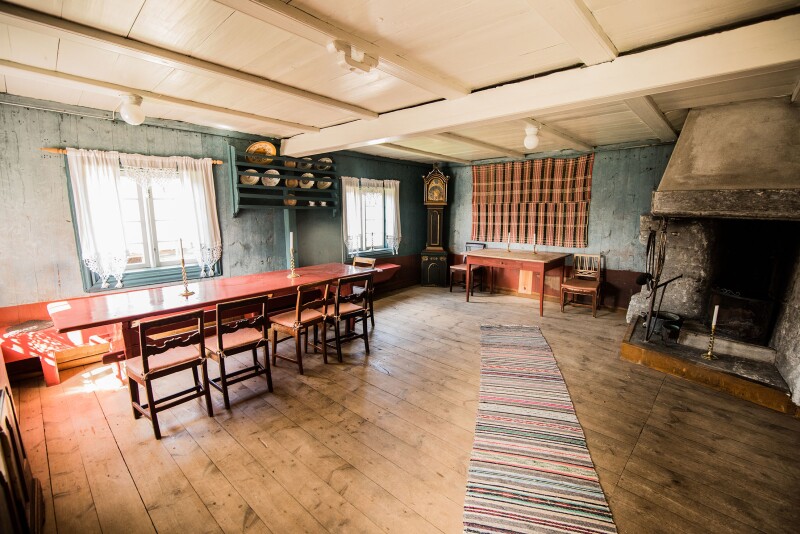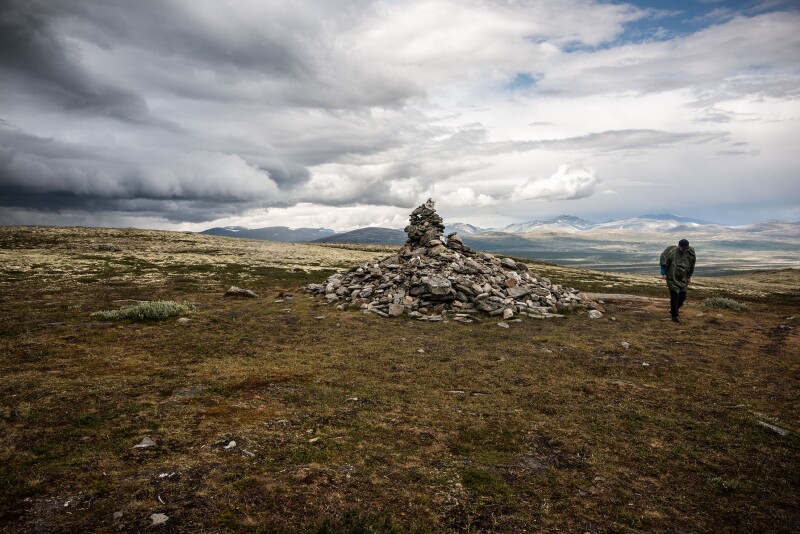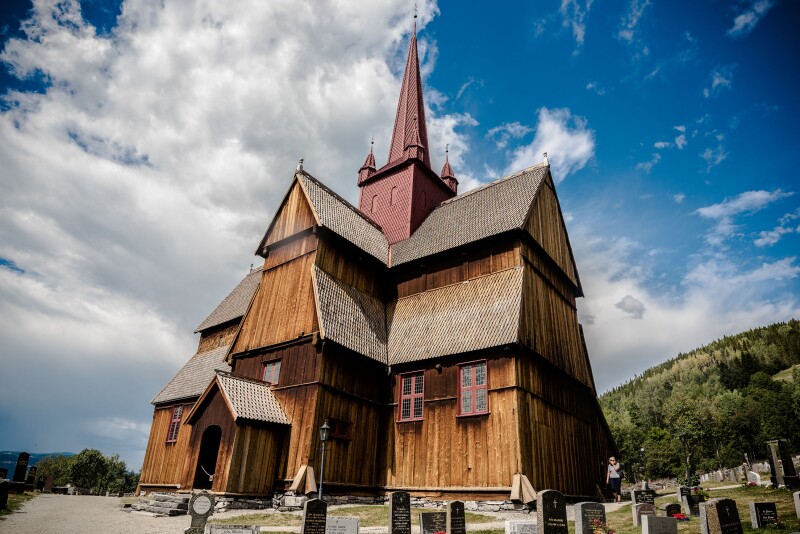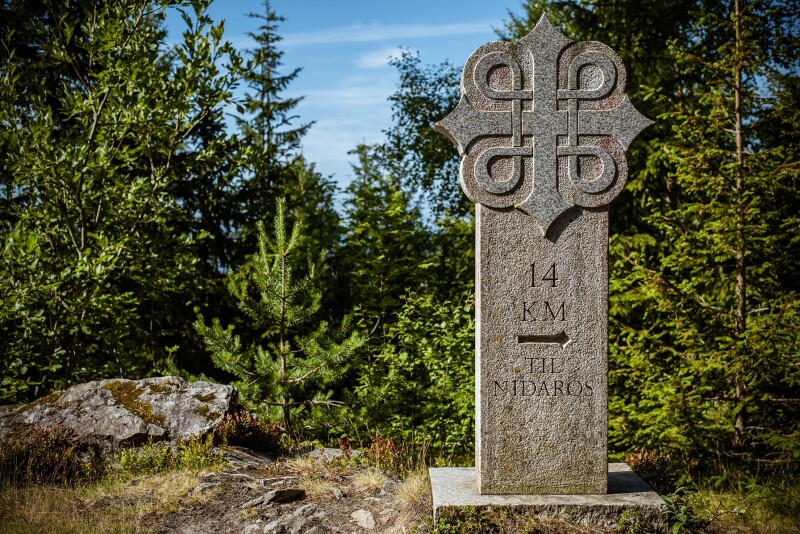Four hundred and eight hikers registered to trek the St. Olav Ways all the way from Oslo to Trondheim in 2017. That’s fewer than the 500 who huff and puff on Peru’s Inca Trail each day. More certainly sampled this 1,000-year-old pilgrimage unofficially, but even if you look at registrants who hiked just the last 100 kilometers (62 miles) to Trondheim’s Nidaros Cathedral—the shortest distance that still warrants the certificate of completion, the prized Olav Letter—that number climbs to a mere 1,040. And Americans? Barely a blip on the radar.
For those uninterested in hiking among crowds to Machu Picchu, following other groups up the Appalachian or Pacific Crest Trails, or sharing a path along Japan’s popular Kumano Kodo, Norway’s “secret” pilgrimage route is a phenomenal alternative. Its appeal is not in bragging rights or as a pseudo-casual drop at a party, but in its serenity. It’s not about cheap wine and fellow backpackers in crowded hostels, but rather homemade soups in creaky farmhouses, silent landscapes with hills that flow to their ends, and time spent with yourself. This is a pilgrimage for the introvert.

Registered trekkers receive a passport in which to document their progress.
Photo by Jacqueline Kehoe
Along the Route
Just like the Kumano Kodo or the Camino, the St. Olav Ways (St. Olavsleden, in Norwegian) isn’t one route, but seven. By far the most popular is the Gudbrandsdalen Path, which also happens to be the longest at 643 kilometers, or 399.5 miles.
As you follow the trail’s red-and-white markers, you’ll be walking a path integral to the Norwegian identity: In 1030, when King Olav II was killed at the Battle of Stiklestad, his body was carried to Trondheim along the last 100 kilometers of the Gudbrandsdalen. Sainthood (and the rest of the routes) would enter the equation when his exhumed body emerged from the dirt a year later “smelling of roses.” Christians then started trekking the St. Olav Ways, up until the Reformation, to pay their homage to the Eternal King.

Hamar Cathedral was built 100 years after Olav’s death. Its sacred ruins were never deconsecrated and are now surrounded by a protective glass shelter.
Photo by Jacqueline Kehoe
Today, the St. Olav Ways is less about saints and kings and more about individuals seeking new beginnings, a sense of calm, a Wi-Fi detox. But you’ll still find the past along the way, marked by large stone tablets indicating your distance to Nidaros, each displaying the pilgrimage symbol, a combination of St. John’s Arms and St. Olav’s Cross. A few notable spots you’ll pass as you get closer and closer to the trail’s end:
643 km (from Nidaros)—St. Hallvard Cathedral Ruins and Memorial Park
The site of Oslo’s first cathedral, St. Hallvard, marks the start of the Gudbrandsdalen. The building was built in the 1100s, and today only the foundation remains. Follow the tram tracks (and the trail markers) toward the suburb of Kampen all the way to Aker church; there you’ll find the Pilegrimssenter Oslo—the Pilgrim Center—where you’ll register for the trek and receive your passport.
488 km—The Cathedral Ruins of Hamar
The 900-year-old Cathedral Ruins of Hamar are now protected—and their acoustics amplified—underneath a triangular glass dome. When you enter, take your steps mindfully; once upon a time, the cathedral didn’t allow the general public to enter the sacred space.

Weary travelers can rest their heads at a variety of accomodations along the trail, from sheltered campsites to historic farmhouses like Budsjord Pilegrimsfarm.
Photo by Jacqueline Kehoe
348 km—Ringebu Stave Church
When the first Christians came to Norway circa 1000 C.E., they built thousands of wooden stave churches. Now only 28 remain, and Ringebu is one of the largest. Ask a guide about the runes in the wall—you’ll never find them without help.325 km—Sygard Grytting
There are very few pilgrim accommodations that have existed since Olav’s era, making Sygard Grytting more than just a place to hang your hat. The 700-year-old farm has always received pilgrims, but the current owners Hilde and Stig Grytting officially turned the family property into a historic lodge. Some rooms feature Victorian elegance while others are more medieval rustic, and any room gets you access to Hilde’s raspberry tart.
Set an intention of self-improvement at the 10-foot cairn in Dovrefjell National Park by adding a stone.
Photo by Jacqueline Kehoe
240 km—Allemansrøysa, Dovre Mountain
The section of the Gudbrandsdalen that winds through the rugged hills of Dovrefjell National Park is perhaps central Norway at its best. It’s also where you’ll have an opportunity to contribute to Allemansrøysa: Once you hit the park’s edge, pick up a small rock, and let it symbolize a feeling or habit you’d like to give up or leave behind. Carry it with you—when you reach the only 10-foot-tall cairn, add your rock to the pile, joining many, many others in a moving example of human complexity.20 km—Sundet Farm
In the mid-1200s, King Magnus VI required all farmers who lived on rivers to hire a ferryman; today, the 14th-century Sundet Farm is one of the last farms maintaining the tradition (despite the nearby bridge). You can wine, dine, and sleep here, too, on what is likely your last night before Trondheim.0 km—Nidaros Cathedral
Legend has it you should circle the cathedral three times before entering. Those extra few hundred steps can be skipped, but be sure to stop at the Pilgrim Center at Nidaros to get your Olav Letter and final passport stamp.
At the time of their construction in the Middle Ages, distinct, wooden stave churches were some of the most elaborate and technologically advanced structures in the region.
Photo by Jacqueline Kehoe
It supposedly takes 32 days to hike the Gudbrandsdalen—that works out to 12.5 miles a day. It’s a good number if you can manage it, as there are small towns and villages with lodging often around this interval. But most hikers aim to cover 15 miles or more per day to allow for rest days and time for exploring. For those with only a week or so to spare, don’t forget that hiking the last 100 kilometers still qualifies you for the coveted Olav Letter.
There are 161 “official” accommodations along the route, including 11 camp shelters and 50 hostels that offer home-cooked meals. So if you wanted to make the trek without full camping gear, you could manage it, although it would require plenty of research and reservations (and the willingness to grab a bus if need be in order to stick to your itinerary). That being said, Norway observes allemansretten—the freedom to roam. Take advantage of it and be sure to pack a hammock or a sleeping pad.

Huge stone tablets placed at intervals along the route display the distance until the pilgrimage’s end.
Photo by Jacqueline Kehoe
As for hiking gear, you’ll definitely need shoes you trust. The highest point on the path is only 4,333 feet, but keep in mind, you’ll be spending weeks on the trail. Be prepared with sufficient rain gear and layers for chillier morning temperatures; the rest of the list matches your standard long-distance hiking needs. You can register your trek at several offices depending on your starting point—don’t be tempted to skip this part. The passport allows you to collect stamps and receive discounts at some tourist spots and accommodations, in addition to being the proof that you’ve hiked the requisite distance to receive the Olav Letter. Both the passport and the letter make fantastic souvenirs, and if you feel like busting them out at that party or posting them on Instagram, go ahead. You earned it.
>>Next: Secluded Mountain Restaurants That Are Worth the Trek











